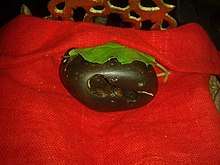Shaligram
Salagrama or Shaligram refers to a fossilized shell used in South Asia as an iconic symbol and reminder of the god Vishnu as the Universal Principle by Hindus of Vaishnavite and Smarthist sects.[1] Shaligrams are usually collected from river-beds or banks such as the Gandaki River in Nepal.[2] They are considered easy to carry and popular in certain traditions of Vaishnavism, as an aniconic representation of the divine. They are typically in the form of spherical, black-coloured Ammonoid fossils of the Devonian-Cretaceous period which existed from 400 to 66 million years ago.

History
Shaligramas are mostly black coloured stones with marks, and are the fossilized remains of now extinct sea dwelling ammonites. Hence they are found in river beds and other regions that were once underwater, the most popular being the Himalayas and Nepal. Historically, the use of Shaligrama (or Salagrama) Shilas in worship can be traced to the time of Adi Shankara through the latter's works. Specifically, his commentary to the verse 1.6.1 in Taittiriya Upanishad [3][4] and his commentary to the verse 1.3.14 of the Brahma Sutras [5] suggest that the use of Saligrama in the worship of Vishnu has been a well-known Hindu practice. A good number of false shaligrams too remain in circulation. Since they were underwater, the belief that these creatures only ate tulsi leaves is a myth.
The largest and heaviest Shaligrama can be seen at the Jagannath Temple, dedicated to Vishnu, at Puri in Orissa. The main ISKCON temple in Scotland, called 'Karuna Bhavan' is famous for housing the largest number of Shaligram Shilas outside of India.
The statue of Lord Vishnu in Ananthashayanam (partially sleeping posture on his snake) posture at the Padmanabhaswamy Temple, Thiruvananthapuram is also made from the Shaligrams of the Gandaki River.
Use
Although Hinduism has many anthropomorphic murtis (images) of gods, aniconism is also represented with such abstract symbols of God as the Salagrama and Shiva lingam.[1]
Configurations
A Shaligrama – which has the marks of a shankha, Chakra, gada and padma arranged in a particular order – is worshiped as Keshava. With the change in the order of the four symbols, the name of the Shaligrama stone is also different and the images of such deities also have similar setting of the four symbols. The various orders and names are given for the twenty four permutations. These are well known names, which are the different names by which Lord Vishnu is known in the Hindu pantheon. The various versions of the Saligrama Shilas or stones vis-a-vis the order of the four symbols are:[6][7]
- Shankha, chakra, gada and padma – Keshava
- Padma, gada, chakra, shankha – Narayana
- Chakra, shankha, padma and gada – Madhava
- Gada, padma, shankha and chakra – Govinda
- Padma, shankha, chakra and gada – Vishnu
- Shankha, padma, gada, chakra – Madusudhana
- Gada, chakra, shankha and padma – Trivikrama
- Chakra, gada, padma, shankha – Vamana
- Chakra, gada, shankha, padma – Shridhara
- Chakra, padma, shankha, gada – Hrishikesh
- Padma, chakra, gada, shankha – Padmanabha
- Shankha, gada, chakra, padma – Damodara
- Shankha, padma, chakra, gada – Sankarshana
- Shankha, chakra, padma, gada – Vasudeva
- Shankha, gada, padma, chakra – Pradyumna
- Gada, shankha, padma, charka – Aniruddha
- Padma, shankha, gada, chakra – Purushottama
- Gada, shankha, chakra, padma – Adokshaja[8]
- Padma, gada, shankha, chakra – Narasimha
- Padma, chakra, shankha, gada – Achyuta
- Chakra, shankha, gada, padma – Janardana
- Gada, chakra, padma, shankha – Upendra
- Chakra, padma, gada and shankha – Hari
- Gada, padma, chakra and shankha – Krishna
References
- Jeanne Fowler, pp. 42–43, at Hinduism: Beliefs and Practices, by M. K. V. Narayan at pp. 84–85 at Flipside of Hindu Symbolism
- "Taking the Lo road in Mustang, Nepal, The National". www.thenational.ae. Retrieved 2016-04-06.
- A. Mahadeva Sastri. Taittiriya Upanishad: with the commentaries of Sankaracharya, Suresvaracharya, and Sayana (Vidyaranya), pp. 80 (free download at: https://archive.org/download/taittiriyaupanis00sankiala/taittiriyaupanis00sankiala.pdf)
- "Taittiriya Upanishad", Chapter 1, Section 6, Verse 1 in The Taittiriya Upanishad, With the Commentaries of Śaṅkarāchārya (url: https://www.wisdomlib.org/hinduism/book/the-taittiriya-upanishad/d/doc79780.html)
- George Thibaut. The Vedanta-Sutras with the Commentary by Sankaracarya: Sacred Books of the East, Volume 1, pp. 178 (url: http://www.bharatadesam.com/spiritual/brahma_sutra/brahma_sutra_sankara_34083.php)
- Debroy, Bibek; Dipavali Debroy (1992). The Garuda Purana. Shalagrama. Lulu.com. p. 42. ISBN 0-9793051-1-X. Retrieved 2009-12-21.
- "Archived copy". Archived from the original on 2010-08-19. Retrieved 2011-01-20.CS1 maint: archived copy as title (link)
- "Adhokshaja". 2 November 2015.
External links
- SRISHALIGRAM
- Rarest of Rare Shaligram Shila - Know the complete details on Shaligram/ Saligram/ Shalagram/
- Sacred Shaligram
- Get Rare and Natural Shaligram from Gandaki River of Nepal
- Garuda-purana Chapter XLV – Characteristic marks of Shalagrama Stones English translation by M.N. Dutt
- Rare Shalagram Temple in India
- Rarest of Rare Shaligram Shila From Gandaki River
- Website for information on Shaligram Shilas
- Information about Shaligram Shilas
- Site dedicated to identification of different types of shaligrams
